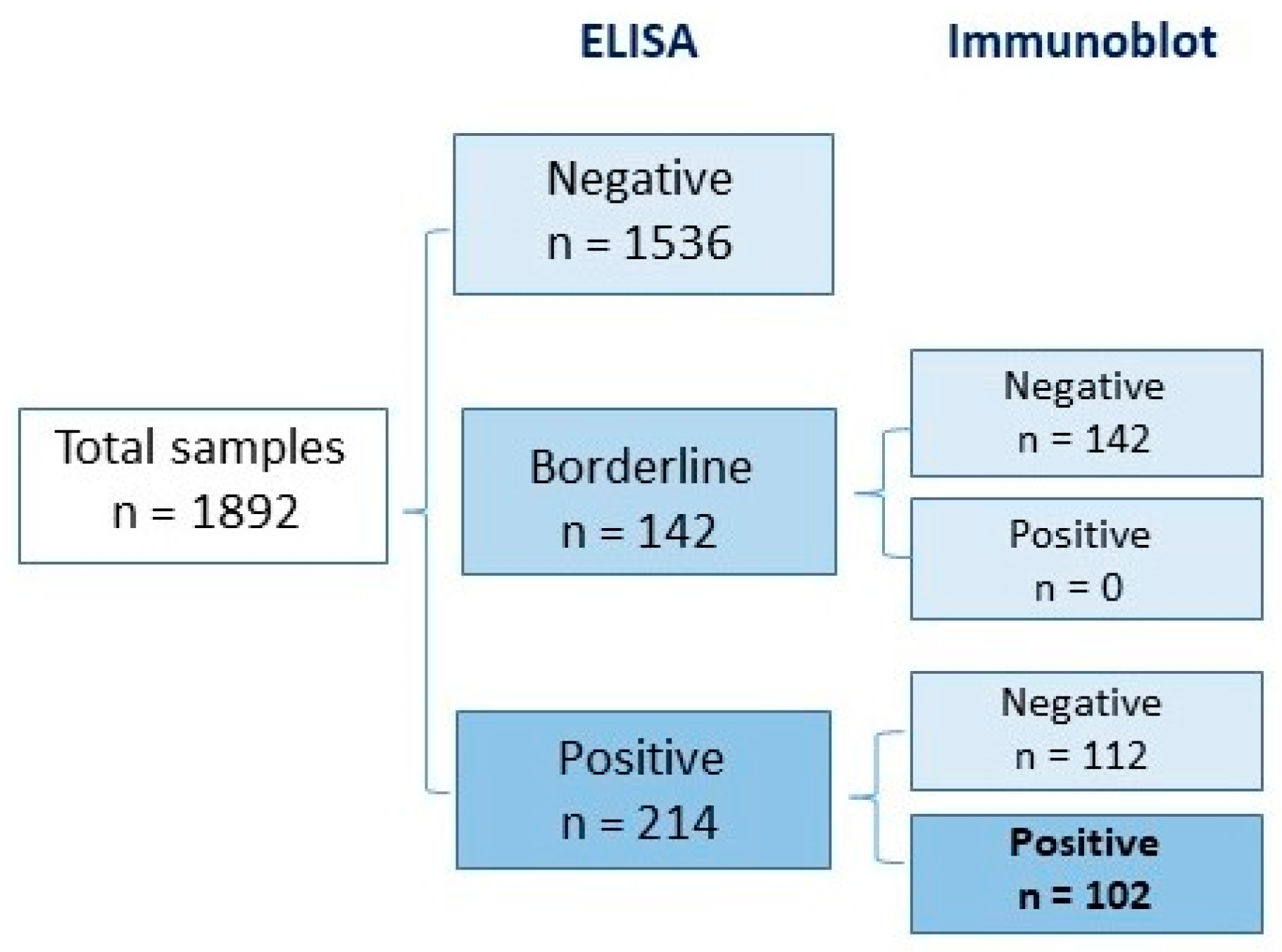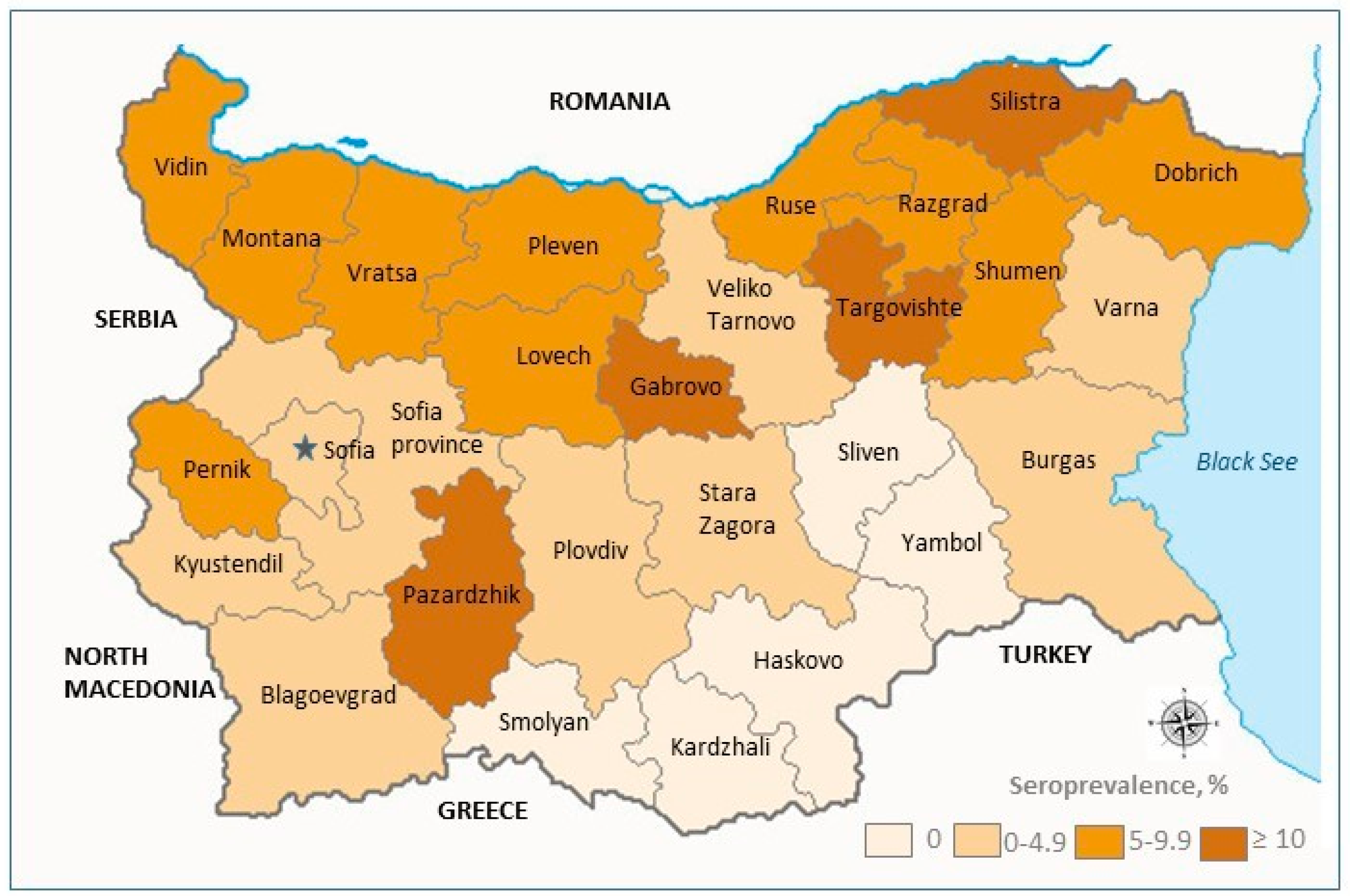Serological Assessment of Lyme borreliosis in Bulgaria: A Nationwide Study
Abstract
:1. Introduction
2. Materials and Methods
3. Results
3.1. Lyme borreliosis Seroprevalence in the General Bulgarian Population
3.2. Geographic Distribution of Lyme borreliosis Prevalence
4. Discussion
Supplementary Materials
Author Contributions
Funding
Institutional Review Board Statement
Informed Consent Statement
Data Availability Statement
Conflicts of Interest
References
- European Centre for Disease Prevention and Control. Factsheet about Borreliosis. Available online: https://www.ecdc.europa.eu/en/borreliosis/facts/factsheet (accessed on 26 August 2024).
- Burn, L.; Vyse, A.; Pilz, A.; Tran, T.M.P.; Fletcher, M.A.; Angulo, F.J.; Gessner, B.D.; Moïsi, J.C.; Stark, J.H. Incidence of Lyme borreliosis in Europe: A Systematic Review (2005–2020). Vector-Borne Zoonotic Dis. 2023, 23, 172–194. [Google Scholar] [CrossRef] [PubMed]
- Burn, L.; Pilz, A.; Vyse, A.; Gutiérrez Rabá, A.V.; Angulo, F.J.; Tran, T.M.P.; Fletcher, M.A.; Gessner, B.D.; Moïsi, J.C.; Stark, J.H. Seroprevalence of Lyme borreliosis in Europe: Results from a Systematic Literature Review (2005–2020). Vector-Borne Zoonotic Dis. 2023, 23, 195–220. [Google Scholar] [CrossRef] [PubMed]
- Kullberg, B.J.; Vrijmoeth, H.D.; van de Schoor, F.; Hovius, J.W. Lyme borreliosis: Diagnosis and management. BMJ 2020, 369, m1041. [Google Scholar] [CrossRef] [PubMed]
- Cardenas-de la Garza, J.A.C.-D.; De la Cruz-Valadez, E.; Ocampo-Candiani, J.; Welsh, O. Clinical spectrum of Lyme disease. Eur. J. Clin. Microbiol. Infect. Dis. 2019, 38, 201–208. [Google Scholar] [CrossRef]
- Radolf, J.D.; Strle, K.; Lemieux, J.E.; Strle, F. Lyme Disease in Humans. Curr. Issues Mol. Biol. 2021, 42, 333–384. [Google Scholar] [CrossRef]
- National Statistical Institute of Bulgaria. Health Services 2023. Available online: https://www.nsi.bg/sites/default/files/files/publications/Zdraveopazvane_2023.pdf (accessed on 23 July 2024).
- Christova, I. Vector-borne infections in Bulgaria. In Vectors and Vector-Borne Zoonotic Diseases; Savić, S., Ed.; IntechOpen: London, UK, 2019; pp. 87–104. [Google Scholar]
- Schoen, R.T. Challenges in the Diagnosis and Treatment of Lyme Disease. Curr. Rheumatol. Rep. 2020, 22, 3. [Google Scholar] [CrossRef]
- Christova, I.; van de Pol, J.; Yazar, S.; Velo, E.; Schouls, L. Identification of Borrelia burgdorferi sensu lato, Anaplasma and Ehrlichia Species, and Spotted Fever Group Rickettsiae in Ticks from Southeastern Europe. Eur. J. Clin. Microbiol. Infect. Dis. 2003, 22, 535–542. [Google Scholar] [CrossRef]
- Blazhev, A.; Stanilov, I.; Miteva, L.D.; Atanasova, M.; Blazheva, S.; Stanilova, S. Prevalence of Borrelia burgdorferi Sensu Lato in Ixodes ricinus Ticks Collected from Kaylaka Park in Pleven, Bulgaria. Microorganisms 2022, 10, 772. [Google Scholar] [CrossRef]
- Nader, J.; Król, N.; Pfeffer, M.; Ohlendorf, V.; Marklewitz, M.; Drosten, C.; Junglen, S.; Obiegala, A. The diversity of tick-borne bacteria and parasites in ticks collected from the Strandja Nature Park in south-eastern Bulgaria. Parasites Vectors 2018, 11, 165. [Google Scholar] [CrossRef]
- Trifonova, I.; Christova, I.; Ivanova-Aleksandrova, N.; Gladnishka, T.; Ivanova, V.; Panayotova, E.; Taseva, E.; Dimitrov, D.; Marinov, M.; Kamenov, G.; et al. Survey of Borrelia burgdorferi sensu lato and West Nile fever virus in wild birds in Bulgaria. Biologia 2022, 77, 3519–3524. [Google Scholar] [CrossRef]
- Tsachev, I.; Pantchev, N.; Marutsov, P.; Petrov, V.; Gundasheva, D.; Baymakova, M. Serological Evidence of Borrelia burgdorferi, Anaplasma phagocytophilum and Ehrlichia spp. Infections in Horses from Southeastern Bulgaria. Vector-Borne Zoonotic Dis. 2018, 18, 588–594. [Google Scholar] [CrossRef] [PubMed]
- Tsachev, I.; Baymakova, M.; Pantchev, N. Seroprevalence of Anaplasma phagocytophilum, Ehrlichia spp. and Borrelia burgdorferi infections in horses: First report from Northern Bulgaria – Short communication. Acta Veter- Hung. 2019, 67, 197–203. [Google Scholar] [CrossRef] [PubMed]
- Pantchev, N.; Schnyder, M.; Vrhovec, M.G.; Schaper, R.; Tsachev, I. Current Surveys of the Seroprevalence of Borrelia burgdorferi, Ehrlichia canis, Anaplasma phagocytophilum, Leishmania infantum, Babesia canis, Angiostrongylus vasorum and Dirofilaria immitis in Dogs in Bulgaria. Parasitol. Res. 2015, 114, 117–130. [Google Scholar] [CrossRef] [PubMed]
- Zarkov, I.S.; Marinov, M.M. The lyme disease: Results of a serological study in sheep, cows and dogs in Bulgaria. Revue Med. Vet. 2003, 154, 363–366. [Google Scholar]
- Christova, I.; Gladnishka, T. Prevalence of infection with Francisella tularensis, Borrelia burgdorferi sensu lato and Anaplasma phagocytophilum in rodents from an endemic focus of tularemia in Bulgaria. Ann. Agric. Environ. Med. 2005, 12, 149–152. [Google Scholar]
- Christova, I.; Dimitrov, H.; Trifonova, I.; Gladnishka, T.; Mitkovska, V.; Stojanova, A.M.; Taseva, E.; Ivanova, V. Detection of Human Tick-borne Pathogens in Rodents from Bulgaria. Acta Zoologica Bulgarica 2012, 64, 111–114. [Google Scholar]
- Kalmár, Z.; Briciu, V.; Coroian, M.; Flonta, M.; Rădulescu, A.-L.; Topan, A.; Mihalca, A.D.; Lupșe, M. Seroprevalence of antibodies against Borrelia burgdorferi sensu lato in healthy blood donors in Romania: An update. Parasites Vectors 2021, 14, 596. [Google Scholar] [CrossRef]
- Jovanovic, D.; Atanasievska, S.; Protic-Djokic, V.; Rakic, U.; Lukac-Radoncic, E.; Ristanovic, E. Seroprevalence of Borrelia burgdorferi in occupationally exposed persons in the Belgrade area, Serbia. Braz. J. Microbiol. 2015, 46, 807–814. [Google Scholar] [CrossRef]
- Akar, N.; Çalışkan, E.; Öztürk, C.E.; Ankaralı, H.; Kılınçel, Ö.; Öksüz, Ş.; Şahin, İ. Seroprevalence of hantavirus and Borrelia burgdorferi in Düzce (Turkey) forest villages and the relationship with sociodemographic features. Turk. J. Med Sci. 2019, 49, 483–489. [Google Scholar] [CrossRef]
- Parlak, M.; Bayram, Y.; Çıkman, A.; Ceylan, N.; Berktaş, M. Seropositivity of Borrelia burgdorferi in risky groups in Van region, Turkey. Mikrobiyoloji Bul. 2015, 49, 439–445. [Google Scholar] [CrossRef]
- Aslan Başbulut, E.; Gözalan, A.; Sönmez, C.; Cöplü, N.; Körhasan, B.; Esen, B.; Akın, L.; Ertek, M. Seroprevalence of Borrelia burgdorferi and tick-borne encephalitis virus in a rural area of Samsun, Turkey. Mikrobiyol. Bul. 2012, 46, 247–256. [Google Scholar]
- Bucak, Ö.; Koçoğlu, M.E.; Taş, T.; Mengeloğlu, F.Z. Evaluation of Borrelia burgdorferi sensu lato seroprevalence in the province of Bolu, Turkey. Turk. J. Med Sci. 2016, 46, 727–732. [Google Scholar] [CrossRef] [PubMed]
- Cikman, A.; Aydin, M.; Gulhan, B.; Karakecili, F.; Demirtas, L.; Kesik, O.A. Geographical Features and Seroprevalence of Borrelia burgdorferi in Erzincan, Turkey. J. Arthropod. Borne. Dis. 2018, 12, 378–386. [Google Scholar] [CrossRef] [PubMed]
- Karcheva, M.; Blazhev, A.; Tsenova, A.; Atanasova, M.; Kostov, K. Retrospective seroepidemiological survey of Lyme borreliosis in Pleven region, Bulgaria. Eur. J. Public Health 2018, 28, cky218-125. [Google Scholar] [CrossRef]
- Jakimovski, D.; Mateska, S.; Dimitrova, E.; Bosilkovski, M.; Mijatović, D.; Simin, V.; Bogdan, I.; Grujić, J.; Budakov-Obradović, Z.; Meletis, E.; et al. Tick-Borne Encephalitis Virus and Borrelia burgdorferi Seroprevalence in Balkan Tick-Infested Individuals: A Two-Centre Study. Pathogens 2023, 12, 922. [Google Scholar] [CrossRef]
- Cora, M.; Kaklıkkaya, N.; Topbaş, M.; Çan, G.; Yavuzyılmaz, A.; Tosun, İ.; Aydın, F. Determination of Seroprevalence of Borrelia burgdorferi IgG in Adult Population Living in Trabzon. Balk. Med J. 2017, 34, 47–52. [Google Scholar] [CrossRef]
- Stamouli, M.; Totos, G.; Braun, H.B.; Michel, G.; Gizaris, V. Very low seroprevalence of Lyme borreliosis in young Greek males. Eur. J. Epidemiology 2000, 16, 495–496. [Google Scholar] [CrossRef]
- Lernout, T.; Kabamba-Mukadi, B.; Saegeman, V.; Tré-Hardy, M.; de Laveleye, M.; Asikainen, T.; Dessau, R.B.; Quoilin, S.; Litzroth, A. The value of seroprevalence data as surveillance tool for Lyme borreliosis in the general population: The experience of Belgium. BMC Public Health 2019, 19, 597. [Google Scholar] [CrossRef]
- Barreiro-Hurlé, L.; Melón-García, S.; Seco-Bernal, C.; Muñoz-Turrillas, C.; Rodríguez-Pérez, M. Seroprevalence of Lyme disease in southwest Asturias. Seroprevalencia de enfermedad de Lyme en el suroccidente de Asturias. Enferm. Infecc. Microbiol. Clin. (Engl Ed.). 2020, 38, 155–158. [Google Scholar] [CrossRef]
- Skufca, J.; Tran, T.M.P.; Brestrich, G.; Pilz, A.; Vyse, A.; Malerczyk, C.; Dzingina, M.; Begier, E.; Blum, M.; Riera-Montes, M.; et al. Incidence of Lyme borreliosis in Germany: Exploring Observed Trends Over Time Using Public Surveillance Data, 2016–2020. Vector-Borne Zoonotic Dis. 2023, 23, 237–246. [Google Scholar] [CrossRef]
- Stadelmann, K.; Forestier, E.; Richalet, G.; Monnet, V.; Epaulard, O. Seroprevalence of Infection by Borrelia Species Responsible for Lyme Disease in the French Alps: Analysis of 27,360 Serology Tests, 2015–2020. Vector-Borne Zoonotic Dis. 2024, 24, 196–200. [Google Scholar] [CrossRef] [PubMed]
- Bušová, A.; Dorko, E.; Feketeová, E.; Rimárová, K.; Diabelková, J.; Rovenská, T.; Csank, T. Association of seroprevalence and risk factors in Lyme disease. Central Eur. J. Public Health 2018, 26, S61–S66. [Google Scholar] [CrossRef] [PubMed]
- Wilking, H.; Fingerle, V.; Klier, C.; Thamm, M.; Stark, K. Antibodies against Borrelia burgdorferi sensu lato among Adults, Germany, 2008–2011. Emerg. Infect. Dis. 2015, 21, 107–110. [Google Scholar] [CrossRef] [PubMed]


| Tested Samples, n (%) | Positive Samples, n (%) | 95% CI | ||
|---|---|---|---|---|
| Age, years | ||||
| 18–39 | 406 (20.5%) | 11 (2.7%) | 1.4–4.8 | |
| 40–65 | 868 (43.8%) | 39 (4.5%) | 3.2–6.1 | |
| over 65 | 618 (31.2%) | 52 (8.4%) | 6.3–10.9 | |
| Sex | ||||
| male | 778 (41.1%) | 65 (8.4%) | 6.5–10.5 | |
| female | 1114 (58.9%) | 37 (3.3%) | 2.3–4.6 | |
| Residence | ||||
| city | 1578 (83.4%) | 70 (4.4%) | 3.5–5.6 | |
| village | 314 (16.6%) | 32 (10.2%) | 4.4–6.5 | |
| Total population | 1892 (100%) | 102 (5.4%) | 4.4–6.5 |
| Province | Tested Samples, n | Positive Samples, n | Seroprevalence, % | 95% CI |
|---|---|---|---|---|
| Overall | 1892 | 102 | 5.4 | 4.4–6.5 |
| Kardzhali | 65 | 0 | 0.0 | - |
| Sliven | 60 | 0 | 0.0 | - |
| Smolyan | 60 | 0 | 0.0 | - |
| Haskovo | 100 | 0 | 0.0 | - |
| Yambol | 60 | 0 | 0.0 | - |
| Burgas | 95 | 1 | 1.1 | 0.0–5.7 |
| Sofia province | 80 | 1 | 1.3 | 0.0–6.8 |
| Plovdiv | 70 | 1 | 1.4 | 0.0–7.7 |
| Blagoevgrad | 63 | 1 | 1.6 | 0.0–8.5 |
| Sofia city | 60 | 1 | 1.7 | 0.0–8.9 |
| Kyustendil | 50 | 1 | 2.0 | 0.1–10.7 |
| Varna | 60 | 2 | 3.3 | 0.4–11.5 |
| Stara Zagora | 60 | 2 | 3.3 | 0.4–11.5 |
| Veliko Tarnovo | 64 | 3 | 4.7 | 1.0–13.1 |
| Dobrich | 60 | 3 | 5.0 | 1.0–13.9 |
| Ruse | 60 | 3 | 5.0 | 1.0–13.9 |
| Pernik | 70 | 4 | 5.7 | 1.6–14.0 |
| Shumen | 82 | 5 | 6.1 | 2.0–13.7 |
| Lovech | 60 | 4 | 6.7 | 2.0–16.2 |
| Montana | 60 | 4 | 6.7 | 1.9–16.2 |
| Pleven | 60 | 4 | 6.7 | 1.9–16.2 |
| Vratsa | 58 | 4 | 6.9 | 1.9–16.7 |
| Vidin | 40 | 3 | 7.5 | 1.6–20.4 |
| Razgrad | 60 | 5 | 8.3 | 2.8–18.4 |
| Pazardzhik | 100 | 10 | 10.0 | 4.9–17.6 |
| Silistra | 60 | 6 | 10.0 | 3.8–20.5 |
| Gabrovo | 95 | 18 | 18.9 | 11.6–28.3 |
| Targovishte | 80 | 16 | 20.0 | 11.9–30.4 |
Disclaimer/Publisher’s Note: The statements, opinions and data contained in all publications are solely those of the individual author(s) and contributor(s) and not of MDPI and/or the editor(s). MDPI and/or the editor(s) disclaim responsibility for any injury to people or property resulting from any ideas, methods, instructions or products referred to in the content. |
© 2024 by the authors. Licensee MDPI, Basel, Switzerland. This article is an open access article distributed under the terms and conditions of the Creative Commons Attribution (CC BY) license (https://creativecommons.org/licenses/by/4.0/).
Share and Cite
Ngoc, K.; Trifonova, I.; Gladnishka, T.; Taseva, E.; Panayotova, E.; Vladimirova, I.; Ivanova, V.; Kuteva, E.; Christova, I. Serological Assessment of Lyme borreliosis in Bulgaria: A Nationwide Study. Pathogens 2024, 13, 754. https://doi.org/10.3390/pathogens13090754
Ngoc K, Trifonova I, Gladnishka T, Taseva E, Panayotova E, Vladimirova I, Ivanova V, Kuteva E, Christova I. Serological Assessment of Lyme borreliosis in Bulgaria: A Nationwide Study. Pathogens. 2024; 13(9):754. https://doi.org/10.3390/pathogens13090754
Chicago/Turabian StyleNgoc, Kim, Iva Trifonova, Teodora Gladnishka, Evgenia Taseva, Elitsa Panayotova, Iva Vladimirova, Vladislava Ivanova, Eleonora Kuteva, and Iva Christova. 2024. "Serological Assessment of Lyme borreliosis in Bulgaria: A Nationwide Study" Pathogens 13, no. 9: 754. https://doi.org/10.3390/pathogens13090754





